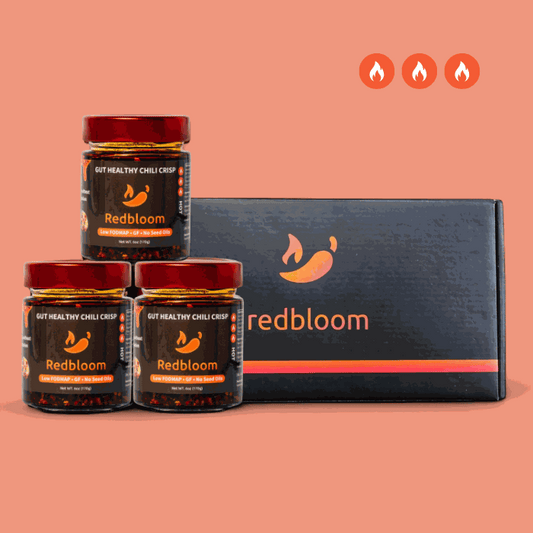Introduction
Spicy food is often seen as the enemy of a sensitive gut—but science is turning that assumption on its head. Capsaicin, the fiery molecule found in chili peppers, may actually hold the key to soothing irritable bowels—especially in cases of diarrhea-predominant IBS (IBS-D).
This blog introduces the concept of capsaicin desensitization therapy, where repeated, controlled doses of chili-derived compounds reduce gut hypersensitivity. We'll explore how capsaicin affects TRPV1 receptors, what clinical research says about its therapeutic potential, and how microencapsulation in oil, like Redbloom’s formulation, is changing how we approach spicy gut health.
What Is Capsaicin Desensitization?
Capsaicin activates TRPV1 receptors—ion channels located on nerve endings in the gastrointestinal tract. These receptors are responsible for transmitting pain, heat, and discomfort signals. When someone with IBS consumes chili, the TRPV1 pathway gets overstimulated, leading to burning, cramping, and urgency [1].
But with repeated exposure, a fascinating thing happens:
-
The nerves experience excess calcium influx
-
This overload leads to functional desensitization
-
Pain signals are reduced over time, and discomfort diminishes [4]
This process is the same mechanism that underpins capsaicin's use in topical creams for joint and nerve pain.
Clinical Evidence for Gut Desensitization
1. Randomized Controlled Trials
A 6-week double-blind, placebo-controlled crossover trial in IBS-D patients showed promising results:
-
Regular chili ingestion reduced abdominal burning
-
Rectal sensory thresholds increased, meaning less nerve sensitivity to distension [1][2][3]
-
While patients initially reported more discomfort in the first two weeks, these symptoms gradually faded, signaling adaptation
This is one of the most direct demonstrations of capsaicin-induced gut desensitization in human subjects.
2. Mechanistic Research
Multiple studies confirm that TRPV1 receptor activation via capsaicin leads to neuropeptide release—specifically substance P and CGRP, which mediate pain and inflammation [4].
However, with continued exposure, these nerves become less reactive, improving visceral pain thresholds and calming overactive gut signals.
3. Meta-Analyses and Reviews
A 2024 meta-analysis concluded that capsaicin may help reduce visceral hypersensitivity (VH) in the long run. While the pain-relieving effect isn’t always statistically significant across all studies, long-term use consistently trended toward reduced discomfort [5][6].
Why Redbloom’s Oil-Based Capsaicin Matters
While raw chilies or hot sauces can cause immediate distress, Redbloom’s oil-based, microencapsulated chili infusion offers a smarter delivery system:
-
Oil buffers capsaicin to slow absorption and reduce sudden gut activation
-
Microdosing allows for gradual exposure, reducing risk of flare-ups
-
Made with organic, gut-friendly ingredients, it’s specifically designed for sensitive stomachs
This approach bridges the gap between therapeutic dosing and real-world usability—turning spice into a functional, gut-calming agent.
How to Use Capsaicin Therapy Safely
Step 1: Begin with Microdoses
Start with 1/4 teaspoon of Redbloom chili oil once per day. Add to a bland base like rice or oatmeal to avoid direct contact with gut walls.
Step 2: Increase Gradually
Every 7–10 days, slightly increase the dose if no symptoms occur. Expect mild warmth or urgency initially—it’s part of the adaptation phase.
Step 3: Maintain Daily Consistency
Capsaicin desensitization is cumulative, not instant. Skipping days or taking inconsistent doses may reset your progress.
Step 4: Avoid Raw or Vinegar-Based Spice
Until your gut is better adapted, steer clear of raw chilies, fermented hot sauces, or spicy vinegar blends that can intensify TRPV1 activation.
Step 5: Track Symptoms
Use a symptom diary or app to monitor bloating, urgency, cramping, or pain. Most people see improvements within 3–6 weeks if the protocol is followed consistently.
Who Can Benefit from Capsaicin Desensitization?
-
IBS-D patients with visceral hypersensitivity and urgency
-
Individuals with functional dyspepsia (upper abdominal discomfort)
-
Anyone with post-inflammatory gut sensitivity recovering from flare-ups
-
Spice lovers who’ve become spice-intolerant over time
Important: Those with active ulcers, severe inflammation, or gastroparesis should consult a GI specialist before starting therapy.
FAQs
1. Is it normal to feel worse before better?
Yes. Most trials reported increased discomfort during the first 1–2 weeks, followed by symptom reduction. This is part of the desensitization phase [1][2].
2. Can I use chili powder or fresh peppers instead?
Not recommended initially. Oil-based, low-dose capsaicin is easier to control and less irritating than raw forms.
3. How long until I feel results?
Most people notice reduced gut sensitivity in 3–6 weeks of daily use, depending on dosage and individual variability.
4. Is Redbloom suitable for sensitive diets?
Yes. It’s made with organic oils and does not contain onion, garlic, or vinegar—making it compatible with Low-FODMAP and anti-inflammatory diets.
5. Can this replace medication?
Capsaicin therapy may reduce your need for symptom control meds over time, but it’s not a substitute for professional treatment. Always consult your doctor.
Conclusion
Capsaicin doesn’t just burn—it can heal. Through consistent exposure in controlled formats, this chili-derived compound can retrain your gut nerves to calm down and stop overreacting.
With tools like Redbloom’s microencapsulated chili oil, this therapy becomes not just possible, but enjoyable. You get the flavor, the warmth, and the potential healing—all in a format designed for sensitive systems.
Start low. Go slow. Spice can soothe.





